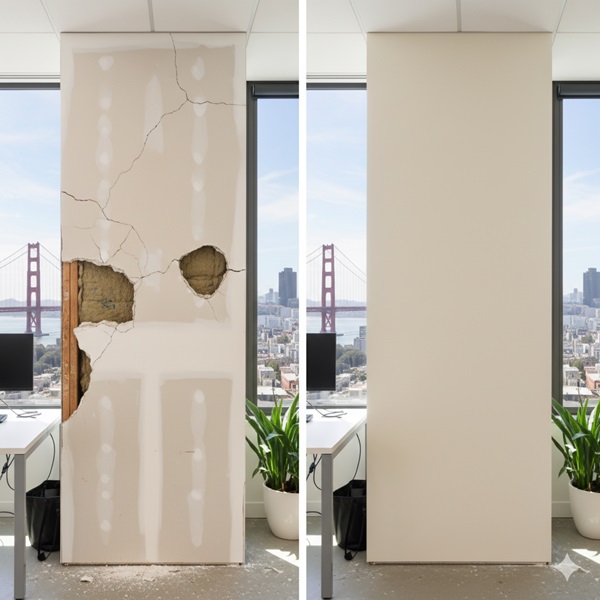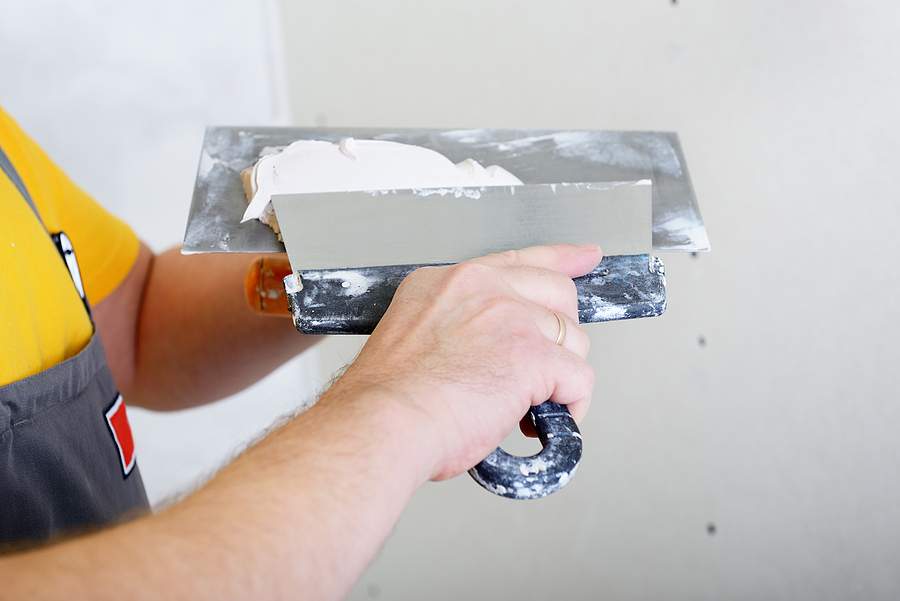Vital Tips for Effective Drywall Fixing and Installment Techniques
Effective drywall repair service and installation requires a mindful strategy. Understanding the types of drywall and having the right devices is vital. Precise measurements and appropriate strategies can significantly influence the end result. Numerous overlook essential actions like taping and sanding, which can make or damage the last look. As jobs progress, usual challenges may emerge that call for interest. Exploring these ideas can cause a much more successful and sleek coating.
Comprehending Various Kinds Of Drywall
Comprehending the numerous kinds of drywall is essential for any kind of effective repair or installation job. Drywall, typically referred to as plaster board, is available in several ranges customized for details applications. Standard drywall is the most extensively made use of kind, suitable for general indoor walls and ceilings. Moisture-resistant drywall, often environment-friendly in shade, is created for locations prone to moisture, such as restrooms and kitchen areas. Fireproof drywall, normally colored pink or purple, is crafted to withstand higher temperatures and is typically utilized in garages or near furnaces. Furthermore, soundproof drywall helps in reducing sound transmission, making it suitable for multi-family homes or videotaping workshops. Specialized drywall, like cement board, is made use of in damp areas like showers or bathtub surrounds. Comprehending these kinds assists in choosing the ideal material for each task, guaranteeing sturdiness and effectiveness in repairs or new installments.
Crucial Devices for Drywall Repair and Setup
Having the right devices is necessary for effective drywall repair work and setup. A quality utility blade is vital for reducing drywall sheets exactly. A drywall T-square helps guarantee straight edges, while a taping knife is necessary for using joint substance efficiently over seams. In addition, a drywall saw allows for eliminating harmed areas or suitable drywall around fixtures.
For hanging drywall, a power drill with drywall screws is important, as it enables secure and quick setup. A level is likewise crucial to verify that the drywall is straight and appropriately lined up. Once it has actually dried, a fining sand block or pole sander is vital for smoothing out joint substance. A determining tape is essential for accurate measurements, preventing waste and ensuring a proper fit. Outfitted with these devices, people can tackle drywall projects successfully, resulting in professional-looking results.
Step-by-Step Guide to Repairing Holes and Cracks
When resolving openings and splits in drywall, having the right devices and products is necessary for a successful repair work. This overview lays out the essential things and supplies a clear, step-by-step procedure to efficiently recover the surface area. Comprehending these components will help guarantee a smooth surface and resilient results.
Devices and Products Needed
A fully equipped toolkit is crucial for reliable drywall repair and installation. Trick tools consist of an utility blade for reducing drywall, a tape step to ensure accurate sizing, and a drywall saw for larger holes. A putty blade is important for applying joint compound efficiently, while a sanding block or post sander aids achieve a seamless surface. For patching, a roll of fiberglass fit together tape or paper tape is required to enhance joints. In addition, a drill and screws are required for securing new drywall items. Crucial products include joint substance, guide, and paint to finish the repair service. Having these devices and materials accessible assures a smoother, extra effective repair service process, yielding professional-looking outcomes.
Repair Service Refine Actions
Fixing holes and fractures in drywall needs a methodical approach to guarantee a seamless surface. The location surrounding the damages must be cleaned up extensively to eliminate dust and debris. Next off, for tiny fractures, a putty blade is made use of to use a joint compound uniformly over the area. For larger openings, a spot is required; the damaged section is removed, and a brand-new item of drywall is suited place, protected with screws. As soon as the patch remains in placement, joint substance is applied to mix the sides. After drying, sanding the location smooth is important. The repaired surface area needs to be keyed and repainted to match the bordering wall surface, making certain a low-profile fixing.
Techniques for Installing Drywall Panels
Mounting drywall panels requires careful planning and accurate execution to guarantee a smooth and expert surface. Initially, it is necessary to measure the wall area properly and cut the panels to fit, making certain that they straighten with the studs. Placing the panels flat is commonly advised, as this can boost the structural stability and lower the number of seams.
Utilizing drywall screws, installers must protect the panels every 16 inches along the studs, guaranteeing a company hold. It is important to avoid overdriving the screws, which can harm the paper surface. For edges and sides, utilizing an energy knife permits clean cuts and a snug fit.

Completing Touches: Taping, Mudding, and Fining sand
Once the drywall panels are safely in position, the next crucial action includes the finishing touches of taping, mudding, and sanding. Insulation is necessary for developing a smooth shift between panels and concealing joints. A high quality drywall tape, either paper or fiberglass harmonize, must be applied over the joints, ensuring it adheres effectively to the mud that will certainly be applied next.
Mudding, or applying joint compound, adheres to the taping process. This substance fills up voids and ravel the surface. An initial coat should be used kindly, feathering the edges to blend with the drywall. After the preliminary coat dries, subsequent layers may be required for a remarkable surface.
Sanding is required to accomplish a smooth surface area. A fine-grit sandpaper needs to be utilized to delicately ravel any blemishes. Treatment visit the site must be required to prevent over-sanding, which can damage the drywall - Drywall Repair Ogden UT. Properly implemented, these completing touches develop an expert look all set for painting
Tips for Keeping Your Drywall After Setup
Preserving drywall after setup is vital to preserving its appearance and architectural integrity. Regular cleaning is essential; dirt and dirt can gather, so mild wiping with a moist fabric is recommended. Property owners should additionally examine for any type of a fantastic read indicators of dampness or mold, specifically in high-humidity areas like bathrooms and cooking areas. If any kind of damage occurs, it is very important to address it without delay to stop more concerns.
Using furnishings pads can aid protect against scratches or dents from hefty things. Additionally, painting the drywall with a premium, cleanable paint provides an extra layer of defense and makes future cleansing simpler. Avoid making use of abrasive cleaners or tools, as these can harm the surface area. Lastly, keeping a steady indoor environment with proper humidity degrees will certainly assist stop breaking or buckling over time. By following these pointers, one can guarantee that drywall stays in excellent condition for several years to come.
Often Asked Inquiries
Just How Lengthy Does Drywall Require To Totally Dry After Installment?

Can I Set Up Drywall Over Existing Drywall?
Yes, drywall can be installed over existing drywall, however it is necessary to assure the underlying surface area is protected and appropriately prepared. This technique can enhance insulation and minimize installation time, though it might include weight.
What Is the very best Method to Soundproof Drywall?
The very best way to soundproof drywall entails making use of specialized soundproofing products, such as resilient networks, acoustic caulk, and sound-dampening drywall. These methods effectively reduce audio transmission in between rooms, enhancing total acoustic efficiency in living areas.
Just how Do I Select the Right Drywall Thickness?
To choose the right drywall thickness, consider the application and location. Standard property walls navigate to this website usually use 1/2 inch, while ceilings or specialized locations might require 5/8 inch for added toughness and soundproofing abilities.
Are There Eco-Friendly Drywall Options Available?
Yes, environment-friendly drywall alternatives are readily available. These consist of products made from recycled products, plaster boards with low unpredictable natural compounds (VOCs), and those making use of lasting production procedures, providing environmentally-conscious selections for building and construction and remodelling projects.
Having the right devices is essential for efficient drywall repair work and setup. For hanging drywall, a power drill with drywall screws is essential, as it allows fast and protected installment. Key devices include an energy knife for reducing drywall, a tape step to guarantee accurate sizing, and a drywall saw for bigger holes. Yes, drywall can be mounted over existing drywall, but it is crucial to guarantee the underlying surface area is protected and effectively prepared. The best method to soundproof drywall involves making use of specialized soundproofing materials, such as durable networks, acoustic caulk, and sound-dampening drywall.